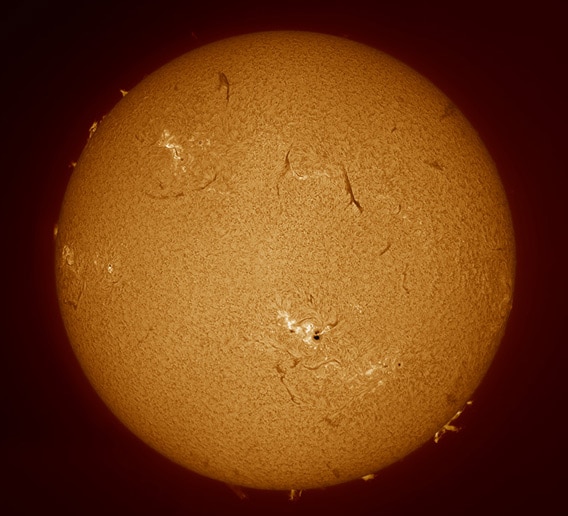Create a free profile to get unlimited access to exclusive videos, sweepstakes, and more!
The Quietly Raging Sun

Itâs been unusually cloudy for this time of year in Boulder, so I havenât been giving the Sun a lot of thought. Plus, except for the odd eruptive prominence or two, it just hasnât been as active as expected lately either.
But donât confuse âinactiveâ with âquietâ and certainly not with âboringâ. Even when the Sun isnât blowing out vast streamers or billion-ton blasts of subatomic particles into space, its surface is still incredibly convoluted and complex. Swedish astrophotographer Göran Strand reminded me of that when he sent me an image of the Sun he took just yesterday, on May 6, 2013:
Yegads! Look at all the action! Strand took this picture using a filter that lets through only a very narrowly-defined color of light, reducing the Sunâs glare (like picking just the red M&Ms out of a bag). In this case, the filter (called an H-alpha filter) only lets through light emitted by warm hydrogen, which is heavily influenced by the Sunâs magnetic activity. Almost everything you see in this picture shows the interplay of the Sunâs fierce magnetic field with the roiling plasma on its surface.
The graininess you see is due to convection: hot parcels of material from deep inside the Sun that rise to the surface, cool off, and sink. They have magnetic fields embedded in them, which is the source of much of the larger structures. Enormous filaments, ribbons of hot material a hundred thousand kilometers long, string across the magnetic field lines, and appear darkly silhouetted against the brighter surface. Small plumes of plasma, called prominences, can be seen around the edgeâthese are actually the same thing as filaments, but they appear bright against the dark sky. Contrast is everything!
And just below center, a bit to the right, a pair of sunspots blemish the solar surface. These are slightly cooler regions, places where the material should be sinking back down into the interior, but are held aloft by the tangled magnetic field lines. Because they are cooler they donât emit as much light as the surrounding surface, and look dark.
The spots look small, donât they? But perhaps youâve forgotten just how mighty our star is. Strand provided a close-up of just that spot, and threw in an image of the Earth for comparison:
So there you go, just in case you didnât yet have your sense of scale stomped flat today. The smaller of those spots is the size of our entire planet! The Sun is a cerebrum-melting 1.4 million kilometers (865,000 miles) across. Thatâs about 110 times the diameter of the Earth. And thatâs just the projected size of the disk: In terms of volume, over a million Earths could fit inside the Sun.
Once your brain is wrapped around that, look again at the picture. You can see filaments of material going between the spots; each spot is like the end of a magnet; one is the north magnetic pole, the other the south. Magnetic field lines connect them, towering loops along which material can flow. You can also see the complex activity in the surface all around the spots, too.
This can be seen more clearly in images taken in the far-ultraviolet, which is only possible from space (our air absorbs that light, so we have to go above it to observe the Sun). Hereâs a shot from NASAâs Solar Dynamics Observatory taken within a few hours of Strandâs observation:
Lovely, isnât it? The orientation is roughly the same (the SDO image is rotated counterclockwise a hair to Strand's pictures), and you can see the gorgeous fine strands of looping plasma going from one sunspot to the other. You can also see several other active regions, too, including the furious chaos going on at the upper right thatâs essentially invisible in Strandâs picture. Observing in different wavelengths, different colors of light, reveals a lot of things that might not be clear at all at a single color. As I pointed out in this morningâs post about volcanoes, with our eyes we only catch a tiny bit of the light that the Universe emits. Its full splendor is lost unless we break free of our natural limitations, and only then do we get a glimpse of what nature truly has to offer.














